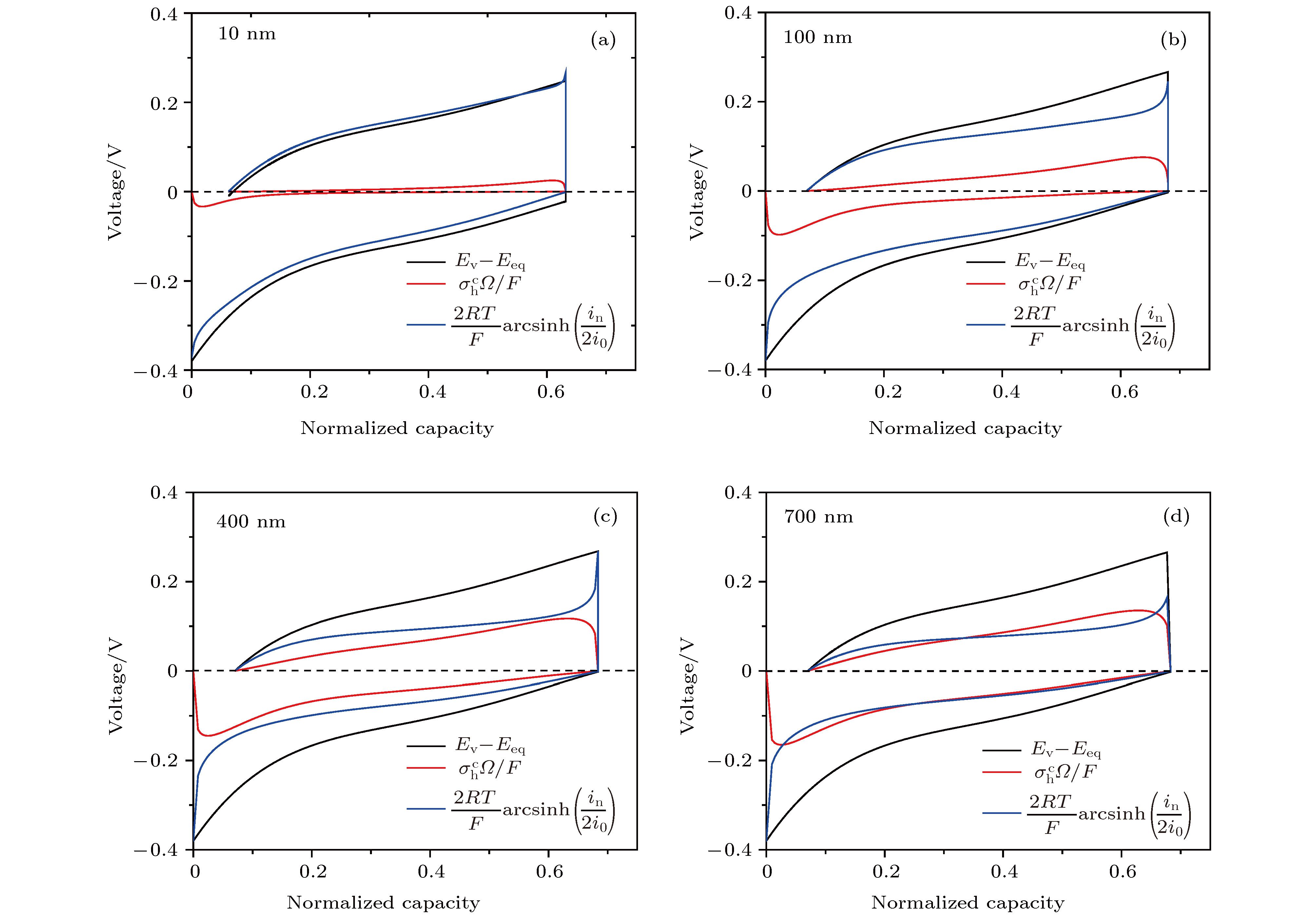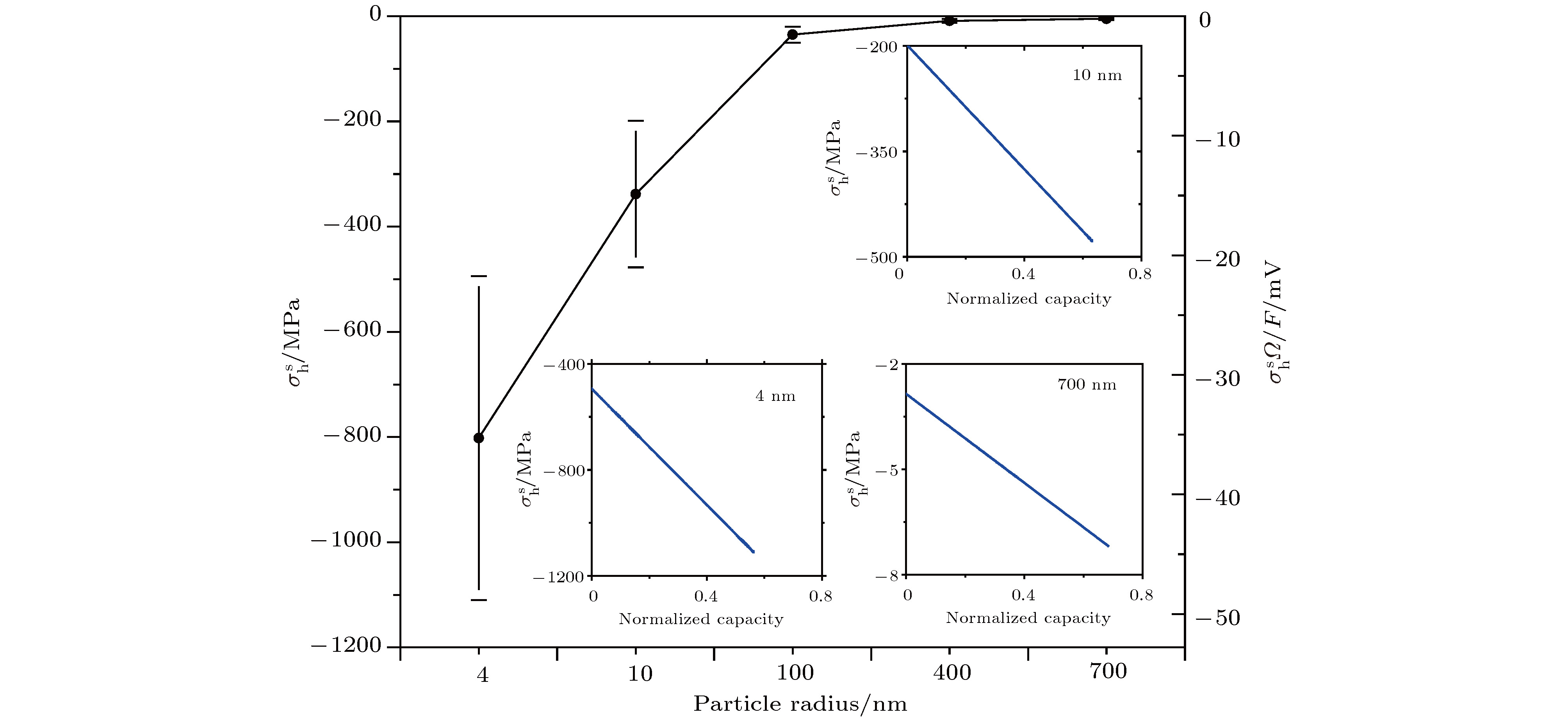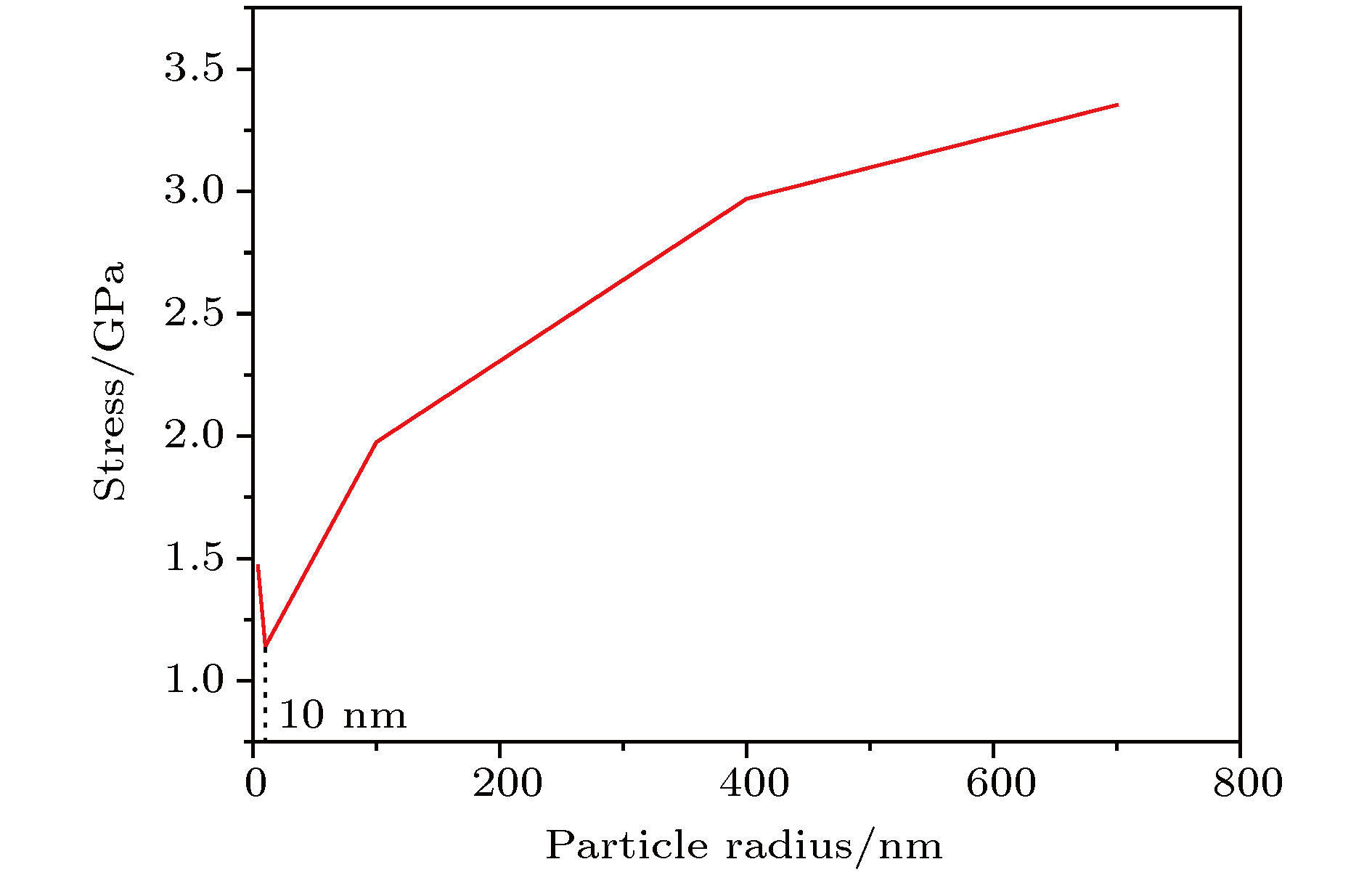-
As one of high capacity electrode materials of lithium ion battery, silicon suffers significant stress effects, which further affects the voltage performance of battery. In this paper, a reaction-diffusion-stress coupled model is established, and the stress induced voltage hysteresis with consideration of diffusion induced stress, surface effects and interparticle compression under potentiostatic operation are investigated. It is found that stress and stress induced voltage hysteresis are dependent on particle size. For big particles, the diffusion induced stress is dominant and further aggravates the hysteresis of both stress and the overpotential consumed by it, indicating that more energy dissipates due to the stress effects. For small particles, especially ones with radius of a few nanometers, surface effects play a more prominent role than diffusion induced stress and the stress evolves into the state of compressive stress on the whole, leading the hysteresis of overpotential to be consumed by stress shrink and making the hysteresis plot of overpotential used to drive electrochemical reaction move downward. The electrode potential first reaches a cutoff voltage and finally the capacity of lithium ion battery decays. Therefore, too large or too small particle size in the electrode can both have a negative effect on the performance of lithium ion batteries, which indicates that an optimal size of the electrode particles must be designed in terms of electrode structure. Based on the calculation, particles with around 9 nm in radius are an appropriate option for electrode design in consideration of both diffusion induced stress and surface effect. In addition, for silicon electrodes, the silicon particles inevitably squeeze each other in a charge and discharge cycle. Therefore, interparticle compression is considered in this case. In detail, interparticle compression pushes the plot of stress hysteresis to the compressive state and leads to lower lithiation capacity, which makes the overpotential plot consumed by stress move downward and accordingly the overpotential plot used to drive the electrochemical reaction move upward. Denser electrode would strengthen this effect due to higher particle compression. It is indicated that for electrode design, the minimum of porosity ratio of electrodes should be adopted because higher interparticle compressive stress would reduce the battery capacity. Our results reveal that the voltage hysteresis of lithium ion batteries is related to the active particle size and the porosity ratio of the electrode, which is of great significance for guiding one in designing the lithium ion batteries.
[1] Konishi H, Hirano T, Takamatsu D, Gunji A, Feng X L, Furutsuki S 2015 J. Power Sources 298 144
 Google Scholar
Google Scholar
[2] Shi S Q, Gao J, Liu Y, Zhao Y, Wu Q, Ju W W, Ouyang C Y, Xiao R J 2016 Chin. Phys. B. 25 18212
 Google Scholar
Google Scholar
[3] Yang L, Chen H S, Jiang H Q, Wei Y J, Song W L, Fang D N 2018 Chem. Commun. 54 3997
 Google Scholar
Google Scholar
[4] McDowell M T, Ryu L, Lee S W, Wang C, Nix W D, Cui Y 2012 Adv. Mater. 24 6034
 Google Scholar
Google Scholar
[5] Liu X H, Fan F F, Yang H, Zhang S, Huang J Y, Zhu T 2013 ACS Nano. 7 1495
[6] Gu M, Yang H, Perea D E, Zhang J G, Zhang S, Wang C M 2014 Nano Lett. 14 4622
 Google Scholar
Google Scholar
[7] Kim S, Choi S J, Zhao K J, Yang H, Gobbi G, Zhang S, Li J 2016 Nat. Commun. 7 10146
 Google Scholar
Google Scholar
[8] Piper D M, Yersak T A, Lee S H 2013 J. Electrochem. Soc. 160 A77
 Google Scholar
Google Scholar
[9] Sethuraman V A, Chon M J, Shimshak M, Srinivasan V, Guduru P R 2010 J. Power Sources 195 5062
 Google Scholar
Google Scholar
[10] Bower A F, Guduru P R, Sethuraman V A 2011 J. Mech. Phys. Solids 59 804
 Google Scholar
Google Scholar
[11] Sethuraman V A, Srinivasan V, Bower A F, Guduru P R 2010 J. Electrochem. Soc. 157 A1253
 Google Scholar
Google Scholar
[12] Lu B, Song Y C, Zhang Q L, Pan J, Cheng Y T, Zhang J Q 2016 Phys. Chem. Chem. Phys. 18 4721
 Google Scholar
Google Scholar
[13] Song Y C, Soh A K, Zhang J Q 2016 J. Mater. Sci. 51 9902
 Google Scholar
Google Scholar
[14] Magasinski A, Dixon P, Hertzberg B, Kvit A, Ayala J, Yushin G 2010 Nat. Mater. 9 353
 Google Scholar
Google Scholar
[15] Meng Q P, Wu L J, Welch D O, Tang M, Zhu Y M 2018 Sci. Rep. 8 4396
 Google Scholar
Google Scholar
[16] Cheng Y T, Verbrugge M W 2008 J. Appl. Phys. 104 083521
 Google Scholar
Google Scholar
[17] Hao F, Gao Z, Fang D N 2012 J. Appl. Phys. 112 103507
 Google Scholar
Google Scholar
[18] Haftbaradaran H, Song J, Curtin W A, Gao H J 2011 J. Power Sources 196 361
 Google Scholar
Google Scholar
[19] Sethuraman V A, Srinivasan V, Newman J 2013 J. Electrochem. Soc. 160 A394
 Google Scholar
Google Scholar
[20] Cheng Y T, Verbrugge M W 2009 J. Power Sources 190 453
 Google Scholar
Google Scholar
[21] Stein P, Zhao Y, Xu B X 2016 J. Power Sources 332 154
 Google Scholar
Google Scholar
[22] Gibbs J W 1906 The Scientific Papers of J. Willard Gibbs (London: Longmans, Green and Company)
[23] Cammarata R C 1994 Prog. Surf. Sci. 46 1
[24] Müller P, Saúl A 2004 Surf. Sci. Rep. 54 157
 Google Scholar
Google Scholar
[25] Rusanov A I 2005 Surf. Sci. Rep. 58 111
[26] Fischer F D, Waitz T, VollathD, Simha N K 2008 Prog. Mater. Sci. 53 481
 Google Scholar
Google Scholar
[27] Gurtin M E, Murdoch A I 1975 Arch. Ration. Mech. An. 57 291
 Google Scholar
Google Scholar
[28] Gurtin M E, Murdoch A I 1978 Int. J. Solids Struct. 14 431
 Google Scholar
Google Scholar
[29] Gurtin M E, Weissmüller J, Larché F 1998 Philos. Mag. A 78 1093
[30] Sharma P, Ganti S, Bhate N 2003 Appl. Phys. Lett. 82 535
 Google Scholar
Google Scholar
[31] Miller R E, Shenoy V B 2000 Nanotechnology 11 139
 Google Scholar
Google Scholar
[32] Luo L, Zhao P, Yang H, Liu B, Zhang J G, Cui Y, Wang C M 2015 Nano Lett. 15 7016
 Google Scholar
Google Scholar
[33] Bucci G, Swamy T, Bishop S, Sheldon B W, Chiang Y M, Carter W C 2017 J. Electrochem. Soc. 164 A645
 Google Scholar
Google Scholar
[34] Roberts A P, Garboczi E J 2000 J. Am. Ceram. Soc. 83 3041
 Google Scholar
Google Scholar
[35] Qi W, Shapter J G, Wu Q, Yin T, Gao G, Cui D 2017 J Mater Chem. A. 5 19521
 Google Scholar
Google Scholar
[36] Roy P, Srivastava S K 2015 J. Mater. Chem. A 3 2454
 Google Scholar
Google Scholar
[37] Vitos L, Ruban A V, Skriver H L 1998 Surf. Sci. 411 186
 Google Scholar
Google Scholar
[38] Yang B, He YP, Irsa J, Lundgren C A, Ratchford J B, Zhao Y P 2012 J. Power Sources 204 168
 Google Scholar
Google Scholar
[39] Gwak Y, Moon J, Cho M 2016 J. Power Sources 307 856
 Google Scholar
Google Scholar
[40] Ding N, Xu J, Yao Y X, Wegner G, Fang X, Chen C H, Lieberwirth 2009 Solid State Ionics 180 222
 Google Scholar
Google Scholar
[41] Ying Z, Peter S, Yang B, Mamun A S, Yangyiwei Y, Xua B X 2019 J. Power Sources 413 259
 Google Scholar
Google Scholar
-
图 2 Sethuraman等[19]硅电极开路电势的拟合结果和实验结果, 其中红色的数据点是实验测得的锂化数据, 蓝色数据点是实验测得的去锂化数据, 实线是在C/8恒流充放电条件下的实验曲线, 虚线是依据实验数据拟合的结果
Figure 2. Fitting results and experimental results of open-circuit potential of silicon electrode proposed by Sethuraman et al.[19]. The red data point is the lithium data measured in the experiment, and the blue data point is the dilithiated data measured in the experiment. The solid line was obtained under a C/8 constant current charge-discharge operation, and the dashed line is the fitting function
图 3 扩散诱导应力对电压迟滞的影响 (a)电极颗粒在锂化和去锂化过程中锂离子的浓度分布; (b)一次充放电循环中, 不同尺寸的颗粒扩散诱导应力演化
Figure 3. Effect of diffusion induced stress on voltage hysteresis: (a) Distribution of concentration of lithium ions in a electrode particle during lithiation and delithiation; (b) diffusion-induced stress evolution diagrams of particles with different sizes in primary charge-discharge cycle
图 5 应力分担过电势的差值、总过电势差值及其所占百分比在不同颗粒尺寸下的变化, 其中差值是指过电势回线中最大值与最小值之差
Figure 5. Dependence of overpotential gap consumed by stress, total overpotential gap and the corresponding percentage on different particle sizes. The gap refers to the difference between the maximum value and the minimum value in the overpotential loop
图 6 由表面效应引起的表面张力及其分担过电势的演化曲线, 其中黑色曲线的应力值为一次充放电循环中的平均应力值, 竖直曲线为各自的变化范围; 3张子图为对应的表面张力演化曲线
Figure 6. Evolution curve of surface tension due to surface effect and the corresponding overpotential. The dark line represents the mean stress in a cycle and the bar defines the range. The three subplots are evolutions of surface stress due to surface effects in a cycle
图 7 (a)不同颗粒尺寸下, 表面张力和扩散诱导应力共同作用下的表面静水应力演化图; (b), (c), (d), (e)分别是颗粒尺寸为4, 10, 100和400 nm时的各部分过电势演化图
Figure 7. (a) Evolution of surface hydrostatic stresses in consideration of both diffusion induced stress and surface effects under different particle sizes; (b), (c), (d), (e) evolutions of all parts of overpotential in the particles of 4, 10, 100 and 400 nm radius, respectively
图 10 颗粒间挤压对电压迟滞的影响 (a) 不同孔隙下电极的应力迟滞回线图; (b)−(e) 不同孔隙率下电极各部分过电势的回线图; 其中p为电池结构的孔隙率
Figure 10. Impacts of interparticle compression on the voltage hysteresis: (a) Stress hysteresis for electrodes with different porosity ratios; (b)−(e) loop diagram of all parts of overpotential in the electrode with different porosity ratios. p is the porosity of the electrode structure.
-
[1] Konishi H, Hirano T, Takamatsu D, Gunji A, Feng X L, Furutsuki S 2015 J. Power Sources 298 144
 Google Scholar
Google Scholar
[2] Shi S Q, Gao J, Liu Y, Zhao Y, Wu Q, Ju W W, Ouyang C Y, Xiao R J 2016 Chin. Phys. B. 25 18212
 Google Scholar
Google Scholar
[3] Yang L, Chen H S, Jiang H Q, Wei Y J, Song W L, Fang D N 2018 Chem. Commun. 54 3997
 Google Scholar
Google Scholar
[4] McDowell M T, Ryu L, Lee S W, Wang C, Nix W D, Cui Y 2012 Adv. Mater. 24 6034
 Google Scholar
Google Scholar
[5] Liu X H, Fan F F, Yang H, Zhang S, Huang J Y, Zhu T 2013 ACS Nano. 7 1495
[6] Gu M, Yang H, Perea D E, Zhang J G, Zhang S, Wang C M 2014 Nano Lett. 14 4622
 Google Scholar
Google Scholar
[7] Kim S, Choi S J, Zhao K J, Yang H, Gobbi G, Zhang S, Li J 2016 Nat. Commun. 7 10146
 Google Scholar
Google Scholar
[8] Piper D M, Yersak T A, Lee S H 2013 J. Electrochem. Soc. 160 A77
 Google Scholar
Google Scholar
[9] Sethuraman V A, Chon M J, Shimshak M, Srinivasan V, Guduru P R 2010 J. Power Sources 195 5062
 Google Scholar
Google Scholar
[10] Bower A F, Guduru P R, Sethuraman V A 2011 J. Mech. Phys. Solids 59 804
 Google Scholar
Google Scholar
[11] Sethuraman V A, Srinivasan V, Bower A F, Guduru P R 2010 J. Electrochem. Soc. 157 A1253
 Google Scholar
Google Scholar
[12] Lu B, Song Y C, Zhang Q L, Pan J, Cheng Y T, Zhang J Q 2016 Phys. Chem. Chem. Phys. 18 4721
 Google Scholar
Google Scholar
[13] Song Y C, Soh A K, Zhang J Q 2016 J. Mater. Sci. 51 9902
 Google Scholar
Google Scholar
[14] Magasinski A, Dixon P, Hertzberg B, Kvit A, Ayala J, Yushin G 2010 Nat. Mater. 9 353
 Google Scholar
Google Scholar
[15] Meng Q P, Wu L J, Welch D O, Tang M, Zhu Y M 2018 Sci. Rep. 8 4396
 Google Scholar
Google Scholar
[16] Cheng Y T, Verbrugge M W 2008 J. Appl. Phys. 104 083521
 Google Scholar
Google Scholar
[17] Hao F, Gao Z, Fang D N 2012 J. Appl. Phys. 112 103507
 Google Scholar
Google Scholar
[18] Haftbaradaran H, Song J, Curtin W A, Gao H J 2011 J. Power Sources 196 361
 Google Scholar
Google Scholar
[19] Sethuraman V A, Srinivasan V, Newman J 2013 J. Electrochem. Soc. 160 A394
 Google Scholar
Google Scholar
[20] Cheng Y T, Verbrugge M W 2009 J. Power Sources 190 453
 Google Scholar
Google Scholar
[21] Stein P, Zhao Y, Xu B X 2016 J. Power Sources 332 154
 Google Scholar
Google Scholar
[22] Gibbs J W 1906 The Scientific Papers of J. Willard Gibbs (London: Longmans, Green and Company)
[23] Cammarata R C 1994 Prog. Surf. Sci. 46 1
[24] Müller P, Saúl A 2004 Surf. Sci. Rep. 54 157
 Google Scholar
Google Scholar
[25] Rusanov A I 2005 Surf. Sci. Rep. 58 111
[26] Fischer F D, Waitz T, VollathD, Simha N K 2008 Prog. Mater. Sci. 53 481
 Google Scholar
Google Scholar
[27] Gurtin M E, Murdoch A I 1975 Arch. Ration. Mech. An. 57 291
 Google Scholar
Google Scholar
[28] Gurtin M E, Murdoch A I 1978 Int. J. Solids Struct. 14 431
 Google Scholar
Google Scholar
[29] Gurtin M E, Weissmüller J, Larché F 1998 Philos. Mag. A 78 1093
[30] Sharma P, Ganti S, Bhate N 2003 Appl. Phys. Lett. 82 535
 Google Scholar
Google Scholar
[31] Miller R E, Shenoy V B 2000 Nanotechnology 11 139
 Google Scholar
Google Scholar
[32] Luo L, Zhao P, Yang H, Liu B, Zhang J G, Cui Y, Wang C M 2015 Nano Lett. 15 7016
 Google Scholar
Google Scholar
[33] Bucci G, Swamy T, Bishop S, Sheldon B W, Chiang Y M, Carter W C 2017 J. Electrochem. Soc. 164 A645
 Google Scholar
Google Scholar
[34] Roberts A P, Garboczi E J 2000 J. Am. Ceram. Soc. 83 3041
 Google Scholar
Google Scholar
[35] Qi W, Shapter J G, Wu Q, Yin T, Gao G, Cui D 2017 J Mater Chem. A. 5 19521
 Google Scholar
Google Scholar
[36] Roy P, Srivastava S K 2015 J. Mater. Chem. A 3 2454
 Google Scholar
Google Scholar
[37] Vitos L, Ruban A V, Skriver H L 1998 Surf. Sci. 411 186
 Google Scholar
Google Scholar
[38] Yang B, He YP, Irsa J, Lundgren C A, Ratchford J B, Zhao Y P 2012 J. Power Sources 204 168
 Google Scholar
Google Scholar
[39] Gwak Y, Moon J, Cho M 2016 J. Power Sources 307 856
 Google Scholar
Google Scholar
[40] Ding N, Xu J, Yao Y X, Wegner G, Fang X, Chen C H, Lieberwirth 2009 Solid State Ionics 180 222
 Google Scholar
Google Scholar
[41] Ying Z, Peter S, Yang B, Mamun A S, Yangyiwei Y, Xua B X 2019 J. Power Sources 413 259
 Google Scholar
Google Scholar
Catalog
Metrics
- Abstract views: 19941
- PDF Downloads: 174
- Cited By: 0















 DownLoad:
DownLoad:










